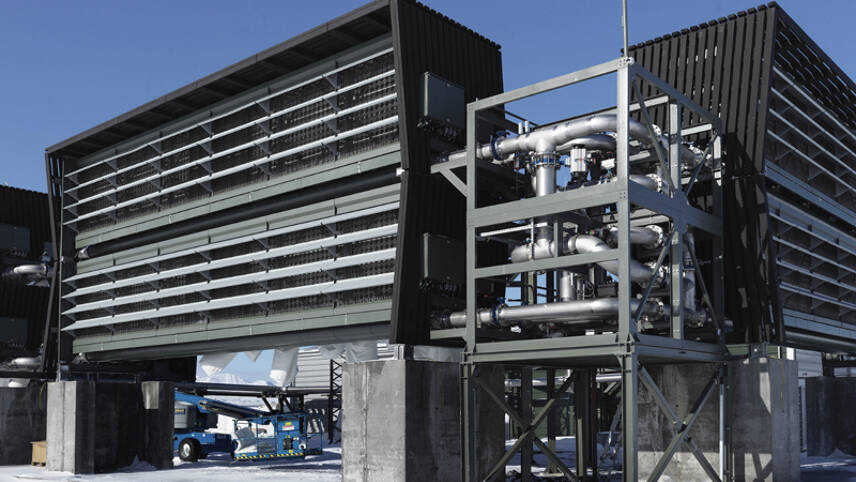This premium content is exclusive to edie Members.
To find out more about edie Membership, please click below.
If you are an existing member, login here

Pictured: Climeworks' Orca direct air capture plant in Iceland. Image: Climeworks
That is the warning from researchers at the University of Oxford and Imperial College London this week.
In a new paper published in the journal Science, spearheaded by the Oxford Sustainable Law Programme, risks relating to governments’ over-reliance on carbon dioxide removal (CDR) technologies are set out.
Chief among them is the risk that CDR technologies will not be deployed at the necessary scale or that they will not deliver the promised levels of carbon removal. The paper explains that this risk is “amplified” by the fact that no nations including CDR in their climate plans have legally binding commitments to scale capacity.
This is a growing concern given the trends seen in the CDR market to date. The global capacity of man-made carbon capture and removal arrays in 2020 was estimated to be 38.5 million tonnes, less than one-thousandth of global emissions that year.
The International Energy Agency (IEA) estimates that carbon capture and removal tech will address around 1% of global energy-related emissions in 2030, rising to up to 5% by 2050.
DeSmog has tracked how several of the world’s largest carbon capture projects have not delivered the level of promised emissions capture to their initial timelines.
There is also, the new paper warns, risks relating to the fact that not all carbon removal and storage options are permanent. It implores policymakers to work with academia, industry and standard-setters to seek assertions that carbon will not leak back into the atmosphere over time.
Further risks explored in the paper include those relating to unintended negative consequences on society and the environment.
The paper outlines how CDR will likely compete in some countries with other land needs including housing, conservation, restoration, agriculture and energy generation. Moreover, CDR developers will need to further assess the long-term impacts of some of their solutions on nature. This spring, communities in Cornwall protested against a CDR project involving the addition of magnesium hydroxide to a wastewater pipe running into the sea, stating that the impact on marine ecosystems must be further explored.
Lead author for the paper, Rupert Stuart-Smith, said that while some CDR will be necessary to achieve the Paris Commitment, his team believes that nations are mainly shying away from deep emissions cuts over the medium term and are placing their bets on CDR for the future.
This, he argued, will “leave a heavy clean-up burden”.
Co-author Joeri Rogelj elaborated: “Inadequate near-term action creates a long-term dependence on removals. If the emissions leading up to net-zero are too high, future generations are handed down a costly legacy that exposes them to additional risks.
“Without legal guidance and limits on CDR use in climate targets, over-reliance on removals may be the next aspect of climate action failure to be challenged in court.”
Is the UK being strategic with its carbon capture approach?
The paper comes in the same week that the Institute for Energy Economics and Financial Analysis (IEEFA) published new research regarding the UK Government’s approach to carbon capture.
Chancellor Jeremy Hunt announced an ambition this spring for the UK to spend £20bn on carbon capture over a 20-year period. This excited the industry after a previous £1bn funding pot was pulled.
The new £20bn will support the deployment of carbon capture at two industrial clusters by the mid-2020s and a further two by the end of the decade. It will also support smaller projects including those co-located with power generation and hydrogen production; the UK is aiming for 10GW of low-carbon hydrogen capacity by 2030 and up to half of this will be for blue hydrogen.
IEEFA’s research revealed that 78% of the carbon capture capacity the UK is planning to host in 2030 will come from projects owned by oil and gas companies.
Most of this capacity will be for blue hydrogen production rather than for abating emissions from industrial processes or gas-fired electricity generation.
The UK has notably pledged to end the use of gas-fired power plants without carbon capture by 2035. There are currently no large gas power plants with carbon capture operating anywhere in the world.
BP is co-developing a gas-fired power station in Teesside and is planning to fit carbon capture technologies. IEEFA is raising concerns that there are currently no firm plans to retrofit carbon capture to existing gas plants; this is a lack of forward planning that could undermine the 2035 commitment.
IEEFA estimates that the UK will likely be at least 70% short of its carbon capture requirements for electricity generation by 2030.
“It is clear that the UK government needs to focus its attention on supporting CCS projects that increase decarbonisation of electricity supply while the UK energy mix transitions to lower-carbon sources,” said IEEFA Europe’s Andrew Reid, author of the report.
“A disproportionate amount of support is currently targeting blue hydrogen production, which not only risks meeting the CCC targets but is questionable longer term as the UK increases renewable power generation and the potential for green hydrogen production.”
A spokesperson for the Department for Energy Security and Net-Zero told edie that carbon capture project selections to date do not represent “the end of the Government’s ambition”. They insisted that the UK is on track to develop ten projects collectively capturing 20 to 30 million tonnes of CO2e per year.
Additionally, the Department has stated that blue hydrogen may be needed to “offer significant carbon savings at scale” while green hydrogen and other fossil-free methods scale up. It has said it will make strategic decisions on hydrogen colours based on affordability.


Please login or Register to leave a comment.